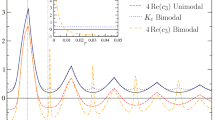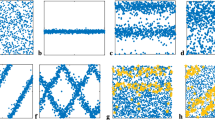Abstract
We construct a nontrivial generalization of the paradigmatic Kuramoto model by using an additional coupling term that explicitly breaks its rotational symmetry resulting in a variant of the Winfree model. Consequently, we observe the characteristic features of the phase diagrams of both the Kuramoto model and the Winfree model depending on the degree of the symmetry breaking coupling strength for unimodal frequency distribution. The phase diagrams of both the Kuramoto and the Winfree models resemble each other for symmetric bimodal frequency distribution for a range of the symmetry breaking coupling strength except for region shift and difference in the degree of spread of the macroscopic dynamical states and bistable regions. The dynamical transitions in the bistable states are characterized by an abrupt (first-order) transition in both the forward and reverse traces. For asymmetric bimodal frequency distribution, the onset of bistable regions depends on the degree of the asymmetry. Large degree of the symmetry breaking coupling strength promotes the synchronized stationary state, while a large degree of heterogeneity, proportional to the separation between the two central frequencies, facilitates the spread of the incoherent and standing wave states in the phase diagram for a low strength of the symmetry breaking coupling. We deduce the low-dimensional equations of motion for the complex order parameters using the Ott-Antonsen ansatz for both unimodal and bimodal frequency distributions. We also deduce the Hopf, pitchfork, and saddle-node bifurcation curves from the evolution equations for the complex order parameters mediating the dynamical transitions. Simulation results of the original discrete set of equations of the generalized Kuramoto model agree well with the analytical bifurcation curves.






Similar content being viewed by others
Data Availability Statement
The data sets on the current study are available from the corresponding author on reasonable request. [Authors’ comment: The homoclinic bifurcation curve is obtained by using XPPAUT software [43].]
References
T. Stankovski, T. Pereira, P.V.E. McClintock, A. Stefanovska, Coupling functions: universal insights into dynamical interactionmechanisms. Rev. Mod. Phys. 89, 045001 (2017)
A. Koseska, E. Volkov, J. Kurths, Transition from amplitude to oscillation death via turing bifurcation. Phys. Rev. Lett. 111, 024103 (2013)
A. Zakharova, M. Kapeller, E. Schöll, Chimera death: symmetry breaking in dynamical networks. Phys. Rev. Lett. 112, 154101 (2014)
T. Banerjee, Mean-field-diffusion?induced chimera death state. EuroPhys. Lett. 110, 69993 (2015)
K. Premalatha, V.K. Chandrasekar, M. Senthilvelan, M. Lakshmanan, Impact of symmetry breaking in networks of globally coupled oscillators. Phys. Rev. E 91, 052915 (2015)
I. Schneider, M. Kapeller, S. Loss, A. Zakharova, B. Fiedler, E. Schöll, Stable and transient multicluster oscillation death in nonlocally coupled networks. Phys. Rev. E 92, 052915 (2015)
K. Premalatha, V.K. Chandrasekar, M. Senthilvelan, M. Lakshmanan, Different kinds of chimera death states in nonlocally coupled oscillators. Phys. Rev. E 93, 052213 (2016)
W. Zou, M. Zhan, J. Kurths, The impact of propagation and processing delays on amplitude and oscillation deaths in the presence of symmetry-breaking coupling, Chaos 27, 114303 (2017). https://doi.org/10.1063/1.5006750
R. Karnatak, R. Ramaswamy, A. Prasad, Amplitude death in the absence of time delays in identical coupled oscillators. Phys. Rev. E 76, 035201(R) (2007)
A. Sharma, M.D. Shrimali, Amplitude death with mean-field diffusion. Phys. Rev. E 85, 057204 (2012)
W. Zou, S. He, C. Yao, Stability of amplitude death in conjugate-coupled nonlinear oscillator networks. Appl. Math. Lett. 131, 108052 (2022)
A.T. Winfree, Biological rhythms and the behaviour of populations of coupled oscillators. J. Theor. Biol. 16, 15 (1967)
A.T. Winfree, The Geomentry of Biological Time (Springer, New York, 1980)
J. Buck, Synchronous rhythmic flashing of fireflies II. Q. Rev. Biol. 63, 265–289 (1988)
Z. Néda, E. Ravasz, T. Vicsek, Y. Brechet, A.L. Barabasi, Physics of the rhythmic applause. Phys. Rev. E 61, 6987 (2000)
Y. Kuramoto, Chemical Oscillations, Waves and Turbulence (Springer, Berlin, 1984)
J.A. Acebron, L.L. Bonilla, C.J.P. Vicente, F. Ritort, R. Spigler, The Kuramoto model: a simple paradigm for synchronization phenomena. Rev. Mod. Phys. 77, 137 (2005)
A. Pikovsky, M. Rosenblum, J. Kurths, Synchronization: A Universal Concept in Nonlinear Science (Cambridge University Press, Cambridge, 2001)
C.S. Peskin, Mathematical Aspects of Heart Physiology (Courant Institute of Mathematical Sciences, New York, 1975)
S.P. Benz, C.J. Burroughs, Coherent emission from two-dimensional Josephson junction arrays. Appl. Phys. Lett. 58, 2162 (1991)
M. Rohden, A. Sorge, M. Timme, D. Witthaut, Self organized synchronization in decentralized power grids. Phys. Rev. Lett. 109, 064101 (2012)
V.K. Chandrasekar, M. Manoranjani, and Shamik Gupta Kuramoto model in the presence of additional interactions that break rotational symmetry. Phys. Rev. E 102, 012206 (2020)
R. Gallego, E. Montbrio, D. Pazo, Synchronization scenarios in the Winfree model of coupled oscillators. Phys. Rev. E 96, 042208 (2017)
J.T. Ariaratnam, S.H. Stroatz, Phase diagram for the Winfree model of coupled nonlinear oscillators. Phys. Rev. Lett. 86, 19 (2001)
F. Giannuzzi, D. Marinazzo, G. Nardulli, M. Pellicoro, S. Stramalia, Phase diagram of a generalized Winfree model. Phys. Rev. E 75, 051104 (2007)
D. Pazo, E. Montbrio, Low-dimensional dynamics of populations of pulse-coupled oscillators. Phys. Rev. X 4, 011009 (2014)
S. Takagi, T. Ueda, Emergence and transitions of dynamic patterns of thickness oscillation of the plasmodium of the true slime mold Physarum polycephalum. Physica D 237, 420 (2008)
Y. Murakami, H. Fukuta, Stability of a pair of planar counter-rotating vortices in a rectangular box. Fluid Dyn. Res. 31, 1 (2002)
H. Fukuta, Y. Murakami, Vortex merging, oscillation, and quasiperiodic structure in a linear array of elongated vortices. Phys. Rev. E 57, 449 (1998)
P. Meunier, T. Leweke, Elliptic instability of a co-rotating vortex pair. J. Fluid. Mech. 533, 125 (2005)
G.N. Throumoulopoulos, H. Tasso, Magnetohydrodynamic counter-rotating vortices and synergetic stabilizing effects of magnetic field and plasma flow. Phys. Plasmas 17, 032508 (2010)
K.T. Kapale, J.P. Dowling, Vortex phase qubit: generating arbitrary, counterrotating, coherent superpositions in Bose-Einstein condensates via optical angular momentum beams. Phys. Rev. Lett. 95, 173601 (2005)
S. Thanvanthri, K.T. Kapale, J.P. Dowling, Arbitrary coherent superpositions of quantized vortices in Bose-Einstein condensates via orbital angular momentum of light. Phys. Rev. A 77, 053825 (2008)
K. Czolczynski, P. Perlikowski, A. Stefanski, T. Kapitaniak, Synchronization of pendula rotating in different directions. Commun. Nonlin. Sci. Num. Simul. 17, 3658 (2012)
M. Kapitaniak, K. Czolczynsk, P. Perlikowski, A. Stefanski, T. Kapitaniak, Synchronous states of slowly rotating pendula. Phys. Rep. 541, 1 (2014)
K. Czolczynski, P. Perlikowski, A. Stefanski, T. Kapitaniak, Synchronization of slowly rotating pendulums. Int. J. Bifurc. Chaos 22, 1250128 (2012)
K. Sathiyadevi, V.K. Chandrasekar, M. Lakshmanan, Emerging chimera states under nonidentical counter-rotating oscillators. Phys. Rev. E 105, 034211 (2022)
M. Tabor, Chaos and Integrability in Nonlinear Dynamics: An Introduction (John Wiley and Sons, New York, 1988)
E. Ott, T.M. Antonsen, Low dimensional behavior of large systems of globally coupled oscillators. Chaos 18, 037113 (2008)
E. Ott, T.M. Antonsen, Long time evolution of phase oscillator systems. Chaos 19, 023117 (2009)
R. Gallego, E. Montbrio, D. Pazo, Phys. Rev. E 96, 042208 (2017)
S. Shinomoto, Y. Kuramoto, Prog. Theor. Phys. 75, 1105 (1986)
B. Ermentrout, Simulating, Analyzing, and Animating Dynamical Systems: A Guide to XPPAUT for Researchers and Students (Society for Industrial & Applied Math, Philadelphia, 2002)
Acknowledgements
The work of V.K.C. is supported by the DST-CRG Project under Grant No. CRG/2020/004353 and DST, New Delhi for computational facilities under the DST-FIST program (SR/FST/PS- 1/2020/135)to the Department of Physics. M.M. thanks the Department of Science and Technology, Government of India, for providing financial support through an INSPIRE Fellowship No. DST/INSPIRE Fellowship/2019/IF190871. S.G. acknowledges support from the Science and Engineering Research Board (SERB), India under SERB-TARE scheme Grant No. TAR/2018/000023 and SERB-MATRICS scheme Grant No. MTR/2019/000560. He also thanks ICTP—The Abdus Salam International Centre for Theoretical Physics, Trieste, Italy for support under its Regular Associateship scheme. DVS is supported by the DST-SERB-CRG Project under Grant No. CRG/2021/000816.
Author information
Authors and Affiliations
Corresponding author
Rights and permissions
Springer Nature or its licensor (e.g. a society or other partner) holds exclusive rights to this article under a publishing agreement with the author(s) or other rightsholder(s); author self-archiving of the accepted manuscript version of this article is solely governed by the terms of such publishing agreement and applicable law.
About this article
Cite this article
Manoranjani, M., Gupta, S., Senthilkumar, D.V. et al. Generalization of the Kuramoto model to the Winfree model by a symmetry breaking coupling. Eur. Phys. J. Plus 138, 144 (2023). https://doi.org/10.1140/epjp/s13360-023-03760-5
Received:
Accepted:
Published:
DOI: https://doi.org/10.1140/epjp/s13360-023-03760-5




